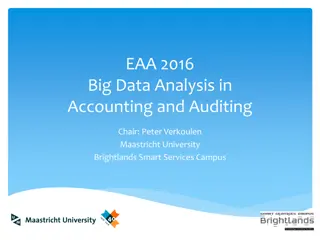Overview of big.LITTLE Technology
This content provides an in-depth exploration of big.LITTLE technology, focusing on its introduction, implementation, and rationale. It discusses features like global task scheduling, supporting GTS in OS kernels, and task distribution policies in heterogeneous multicore processors. The technology's impact on power management and task efficiency is also analyzed with illustrative examples and expected results. Furthermore, it introduces the concept of master/slave processing and heterogeneous core clusters for efficient task execution.
Download Presentation

Please find below an Image/Link to download the presentation.
The content on the website is provided AS IS for your information and personal use only. It may not be sold, licensed, or shared on other websites without obtaining consent from the author.If you encounter any issues during the download, it is possible that the publisher has removed the file from their server.
You are allowed to download the files provided on this website for personal or commercial use, subject to the condition that they are used lawfully. All files are the property of their respective owners.
The content on the website is provided AS IS for your information and personal use only. It may not be sold, licensed, or shared on other websites without obtaining consent from the author.
E N D
Presentation Transcript
big.LITTLE technology Dezs Sima Vers. 2.1 December 2015
big.LITTLE technology 1. Introduction to the big.LITTLE technology 2. Exclusive cluster migration (not discussed) 3. Inclusive cluster migration (not discussed) 4. Exclusive core migration (not discussed) 5. Global task scheduling (GTS) 6. Supporting GTS in OS kernels (partly discussed) 7. References
1. Introduction to the big.LITTLE technology 1.1 The rationale for big.LITTLE processing 1.2 Principle of big.LITTLE processing 1.3 Implementation of the big.LITTLE technology
1.1 The rationale for big.LITTLE processing (2) Example: Percentage of time spent in DVFS states and further power states in a dual core mobile device for low intensity applications [9] -1 (Core) WFI: Waiting for Interrupt The mobile device is a dual core Cortex-A9 based mobile device. In the diagram, the red color indicates the highest, green the lowest frequency operating point whereas colors in between represent intermediate frequencies. In addition, the OS power management idles a CPU for Waiting for Interrupt (WFI) (light blue) or even shuts down a core (dark blue) or the cluster (darkest blue).
1.1 The rationale for big.LITTLE processing (4) Expected results of using the big and LITTLE technology [2]
1.1 The rationale for big.LITTLE processing (5) big.LITTLE technology as an option of task distribution policy in heterogeneous multicore processors Task distribution policies in heterogeneous multicore processors Master/slave processing Task forwarding to a dedicated accelerator Task migration to different kind of CPUs Heterogeneous master/slave processing Heterogeneous attached processing Heterogeneous big.LITLE processing Beyond a CPU there are dedicated accelerators, like a GPU available. The CPU forwards an instructon to an accelerator when it is capable to execute this instruction more efficiently than the CPU. There two or more clusters of cores, e.g. two clusters; a LITTLE and a big one. Cores of the LITTLE cluster execute less demanding tasks and consume less power, whereas cores of the big cluster execute more demanding tasks with higher power consumption. There is a master core (MCP) and a number of slave cores. The master core organizes the operation of the slave cores to execute a task http://community.arm.com/servlet/JiveServlet/downloadImage/38-1507-2885/blogentry-107443-025420200+1375802671_thumb.png MPC Slave cores CPU GPU
1.2 Principle of big.LITTLE processing (1) 1.2 Principle of big.LITTLE processing [6]
1.2 Principle of big.LITTLE processing (2) Assumed platform Let s have two or more clusters of architecturally identical cores in a processor. As an example let s take two clusters; a cluster of low performance/low power cores, termed as the LITTLE cores and a cluster of higher performance higher power cores, termed as the big cores, as seen in the Figure below. Cluster of big cores Cluster of LITTLE cores CPU0 CPU1 CPU0 CPU1 Figure: A big.LITTLE configuration consisting of two clusters CPU2 CPU3 CPU2 CPU3 Cache coherent interconnect To memory Let s interconnect these clusters by a cache coherent interconnect to have a multicore processor, as indicated in the Figure.
1.2 Principle of big.LITTLE processing (4) Example: Operating points of a multiprocessor built up of two core clusters: one of LITTLE cores (Cortex-A7) and one of big cores (Cortex-A15), as described above [3]
1.2 Principle of big.LITTLE processing (5) Example big (Cortex-A15) and LITTLE cores (Cortex-A7) [3]
1.2 Principle of big.LITTLE processing (6) Performance and energy efficiency comparison of the Cortex-A15 vs. the Cortex-A7 cores [3]
1.2 Principle of big.LITTLE processing (8) Illustration of the described model of operation [7] Note that at low load the LITTLE (A7) and at high load the big (A15) cluster is operational.
1.3 Implementation of the big.LITTLE technology (2) Example block diagram of a two cluster big.LITTLE SOC design [1] ADB-400: AMBA Domain Bridge AMBA: Advanced Microcontroller Bus Architecture MMU-400: Memory Management Unit TZC: Trust Zone Address Space Controller
1.3 Implementation of the big.LITTLE technology (4) Design space of the implementation of the big.LITTLE technology In our discussion of the big.LITTLE technology we take into account three basic design aspects, as follows: Implementation of the big-LITTLE technology No. of core clusters and no. of cores per cluster Options for supplying core frequencies and voltages Basic scheme of task scheduling These aspects will be discussed subsequently.
1.3 Implementation of the big.LITTLE technology (5) Design space of the implementation of the big.LITTLE technology In our discussion of the big.LITTLE technology we identify three basic design aspects, as follows: Implementation of the big-LITTLE technology Options for supplying core frequencies and voltages Basic scheme of task scheduling No. of core clusters and no. of cores per cluster These aspects will be discussed subsequently.
1.3 Implementation of the big.LITTLE technology (6) Number of core clusters and number of cores per cluster Number of core clusters and number of cores per cluster Three core clusters used Dual core clusters used 4 + 4 2 + 2 1 + 4 Example configurations 4 + 4 + 2 4 + 2 + 4 Cluster of big cores Cluster of LITTLE cores running at a lower core frequeency Cluster of LITTLE cores running at a higher core fequency Cluster of big cores Cluster of LITTLE cores CPU0 CPU1 CPU0 CPU1 CPU0 CPU1 CPU0 CPU1 CPU2 CPU3 CPU2 CPU3 CPU2 CPU3 CPU2 CPU3 CPU2 CPU3 Cache coherent interconnect Cache coherent interconnect Memory Memory
1.3 Implementation of the big.LITTLE technology (7) Example 1: Dual core clusters, 4+4 cores: Samsung Exynos Octa 5410 [11] It is the world s first octa core mobile processor. Announced in 11/2012, launched in some Galaxy S4 models in 4/2013. Figure: Block diagram of Samsung s Exynos 5 Octa 5410 [11]
1.3 Implementation of the big.LITTLE technology (8) Example 2: Three core clusters, 2+4+4 cores: Helio X20 (MediaTek MT6797) In this case, each core cluster has different operating characteristics, as indicated in the next Figures. Announced in 9/2015, to be launched in HTC One A9 in 11/2015. Figure: big.LITTLE implementation with three core clusters (MT6797) [46]
1.3 Implementation of the big.LITTLE technology (9) Power-performance characteristics of the three clusters [47]
1.3 Implementation of the big.LITTLE technology (10) Basic scheme of task scheduling Implementation of the big-LITTLE technology Options for supplying core frequencies and voltages Basic scheme of task scheduling No. of core clusters and no. of cores per cluster
1.3 Implementation of the big.LITTLE technology (11) Basic scheme of task scheduling Basic scheme of task scheduling Task scheduling based on core migration Task scheduling based on cluster migration
1.3 Implementation of the big.LITTLE technology (12) Task schedulinng based on cluster migration (assuming two clusters) Task scheduling based on cluster migration Inclusive use of the clusters Exclusive use of the clusters For low workloads only the LITTLE but for high workloads both the big and the LITTLE clusters are in use At any time either the big or the LITTLE cluster is in use High load Low load High load Low load Cluster of big cores Cluster of big cores Cluster of big cores Cluster of big cores Cluster of LITTLE cores Cluster of LITTLE cores Cluster of LITTLE cores Cluster of LITTLE cores CPU0 CPU1 CPU0 CPU1 CPU0 CPU1 CPU0 CPU1 CPU0 CPU1 CPU0 CPU1 CPU0 CPU1 CPU0 CPU1 CPU2 CPU3 CPU2 CPU3 CPU2 CPU3 CPU2 CPU3 CPU2 CPU3 CPU2 CPU3 CPU2 CPU3 CPU2 CPU3 Cache coherent interconnect Cache coherent interconnect Cache coherent interconnect Cache coherent interconnect Exclusive cluster migration Inclusive cluster migration
1.3 Implementation of the big.LITTLE technology (13) Task scheduling based on core migration (assuming two clusters) Task scheduling based on core migration Inclusive use of all big and LITTLE cores Exclusive use of cores in big.LITTLE core pairs Both big and LITTLE cores may be used at the same time. A global scheduler allocates the workload appropriately for all available big and the LITTLE cores. big and LITTLE cores are ordered in pairs. In each core pair either the big or the LITTLE core is in use. Global scheduler Exclusive core migration [48] Global Task Scheduling [48]
1.3 Implementation of the big.LITTLE technology (14) Basic design space of task scheduling in the big.LITTLE technology Basic scheme of task scheduling in the big-LITTLE technology Task scheduling based on core migration Task scheduling based on cluster migration Inclusive use of the clusters Exclusive use of the clusters Inclusive use of all cores in all clusters Exclusive use of cores in big.LITTLE core pairs Inclusive cluster migration Global Task scheduling (GTS) Heterogeneous Multi-Processing (HMP) Exclusive core migration In Kernel Switcher (IKS) Exclusive cluster migration Nvidia s Variable SMP Described first in ARM/Linaro EAS project (2015) [49] Described first in ARM s White Paper (2012) [9] Described first in ARM s White Paper (2011) [3] Described first in ARM s White Paper (2011) [3] Used first in Nvidia sTegra 3 (2011) (1 A9 LP + 4 A9 cores) Tegra 4 (2013) (1 LP core + 4 A15 cores) No known implementation ARM/Linaro EAS project in progress (2013-) Implemented by Linaro on ARM s experimental TC2 system (2013) (3 A7 + 2 A15 cores) Mediatek MT8135 (2013) (2 A7 + 2 A 15 cores) Samsung HMP on Exynos 5 Octa 5420 (2013) (4 A7 + 4 A15 cores) Samsung Exynos 5 Octa 5410 (2013) (4 A7 + 4 A15 cores) Allwinner UltraOcta A80 (2014) (4 A7 + 4 A15 cores) Qualcomm Snapdragon S 808 (2014) (4 A53 + 2 A57 cores)
1.3 Implementation of the big.LITTLE technology (15) Options for supplying core frequencies and voltages Implementation of the big-LITTLE technology Options for supplying core frequencies and voltages Basic scheme of task scheduling No. of core clusters and cores per cluster
1.3 Implementation of the big.LITTLE technology (16) Options for supplying core frequencies and voltages-1 Options for supplying core frequencies and voltages in SMPs Synchronous CPU cores Semi-synchronous CPU cores Asynchronous CPU cores The same core frequency and core voltage for all cores Individual core frequencies but the same core voltage for the cores Individual core frequencies and core voltages for all cores Examples in mobiles Typical in ARM s design in their Cortex line Used within clusters of big.LITTLE configurations, e.g. ARM s big.LITTLE technology (2011) Nvidia s vSMP technology (2011) No known implementation Qualcomm Snapdragon family with the Scorpion and then the Krait and Kryo cores (since 2011)
1.3 Implementation of the big.LITTLE technology (17) Example 1: Per cluster core frequencies and voltages in ARM s test chip [10] PSU: Power Supply Unit DCC: Cortex-M3
1.3 Implementation of the big.LITTLE technology (18) Example 2: Per core power domains in the Cortex A-57 MPcore [50] Note: Each core has a separate power domain nevertheless, actual implementations often let operate all cores of a cluster at the same frequency and voltage.
1.3 Implementation of the big.LITTLE technology (19) Remark: Implementation of DVFS in ARM processors ARM introduced DVFS relatively late, about 2005 first in their ARM11 family. It was designed as IEM (Intelligent Energy Management) (see Figure below). Figure: Principle of ARM s IEM (Intelligent Energy Management) technology [51]
2. Exclusive cluster migration (Not discussed)
2. Exclusive cluster migration (1) 2. Exclusive cluster migration Implementation of task scheduling in the big-LITTLE technology Task scheduling based on core migration Task scheduling based on cluster migration Inclusive use of the clusters Exclusive use of the clusters Inclusive use of all cores in all clusters Exclusive use of cores in big.LITTLE core pairs Inclusive cluster migration Global Task scheduling (GTS) Heterogeneous Multi-Processing (HMP) Exclusive core migration In Kernel Switcher (IKS) Exclusive cluster migration Nvidia s Variable SMP Described first in ARM/Linaro EAS project (2015) [49] Described first in ARM s White Paper (2012) [9] Described first in ARM s White Paper (2011) [3] Described first in ARM s White Paper (2011) [3] Used first in Nvidia sTegra 3 (2011) (1 A9 LP + 4 A9 cores) Tegra 4 (2013) (1 LP core + 4 A15 cores) No known implementation ARM/Linaro EAS project in progress (2013-) Implemented by Linaro on ARM s experimental TC2 system (2013) (3 A7 + 2 A15 cores) Mediatek MT8135 (2013) (2 A7 + 2 A 15 cores) Samsung HMP on Exynos 5 Octa 5420 (2013) (4 A7 + 4 A15 cores) Samsung Exynos 5 Octa 5410 (2013) (4 A7 + 4 A15 cores) Allwinner UltraOcta A80 (2014) (4 A7 + 4 A15 cores) Qualcomm Snapdragon S 808 (2014) (4 A53 + 2 A57 cores)
2. Exclusive cluster migration (2) Principle of the exclusive cluster migration-1 For simplicity, let s have two clusters of cores, as usual, e.g. with 4 cores each; a cluster of low power/low performance cores, termed as the LITTLE cores and a cluster of high performance high power cores, termed as the big cores, as indicated below. Cluster of big cores Cluster of LITTLE cores CPU0 CPU1 CPU0 CPU1 CPU2 CPU3 CPU2 CPU3 Cache coherent interconnect To memory Use the cluster of LITTLE cores for less demanding workloads, whereas the cluster of big cores for more demanding workloads, as indicated in the next Figure.
2. Exclusive cluster migration (3) Principle of the exclusive cluster migration-2 [4] The OS (e.g. the Linux cpufreq routine) tracks the load for all cores in the cluster. As long as the actual workload can be executed by the low power, low performance cluster, this cluster will be activated. If however the workload requires more performance than available with the cluster of LITTLE cores (CPU A in the Figure), an appropriate routine performs a switch to the cluster of high performance high power big cores (CPU B). LITTLE cores big cores
2. Exclusive cluster migration (4) Main components of an example system The example system includes a cluster of two Cortex-A15 cores, used as the big cluster and another cluster of two Cortex-A7 cores, used as the LITTLE, cluster, as indicated below. General Interrupt Controller Figure: An example system assumed while discussing exlusive cluster migration [3] Both clusters are interconnected by a Cache Coherent Interconnect (CCI-400) and are served by a General Interrupt Controller (GIC-400), as shown above.
2. Exclusive cluster migration (5) Pipelines of the big Cortex-15 and the LITTLE Cortex-A7 cores [3] Cortex-A7 Cortex-A15
2. Exclusive cluster migration (6) Contrasting performance and energy efficiency of the Cortex-A15 and Cortex-A7 cores [3]
2. Exclusive cluster migration (7) Voltage domains and clocking scheme of the V2P-CA15_CA7 test chip [10] DCC: Cortex-M3
2. Exclusive cluster migration (10) Operating points of the Cortex-A15 and Cortex-A7 cores [3]
2. Exclusive cluster migration (11) The process of cluster switching [3] Currently inactive cluster Currently active cluster
2. Exclusive cluster migration (13) Implementation example: Samsung Exynos Octa 5410 [11] It is the world s first octa core processor. Announced in 11/2012, launched in some Galaxy S4 models in 4/2013. Figure: Block diagram of Samsung s Exynos 5 Octa 5410 [11]
2. Exclusive cluster migration (14) Operation of the Exynos 5 Octa 5410 using exclusive cluster switching [12] http://images.anandtech.com/doci/6768/Screen%20Shot%202013-02-20%20at%2012.42.41%20PM_575px.png It was revealed at the International Solid-State Circuit Conference (ISSCC) in 2/2013, without specifying the chip designation.
2. Exclusive cluster migration (16) Assumed die photo of Samsung s Exynos 5 Octa 5410 [12] It was revealed at the International Solid-State Circuit Conference (ISSCC) in 2/2013 without specifying the chip designation.
2. Exclusive cluster migration (17) Performance and power results of the Exynos 5 Octa 5410 [11]
2. Exclusive cluster migration (18) Nvidia s variable SMP Nvidia preferred to implement exclusive cluster migration with a LITTLE cluster including only a single core, and a big cluster with four cores, as indicated in the next Figure. E.g. Cluster of CPU0 Cluster of a single low power core CPU1 high performance cores CPU2 CPU3 CPU0 Cache coherent interconnect Figure: Example layout of Nvidia s variable SMP Nvidia designates this implementation of big-LITTLE technology as variable SMP. It was implemented early in the Tegra 3 (2011) with one A9 LP + 4 A9 cores and subsequently in the Tegra 4 (2013) with one LP core + 4 A15 cores.
2. Exclusive cluster migration (19) Power-Performance curve of Nvidia s variable SMP [4] Note that in the Figure the LITTLE core is designated as Companion core whereas the big cores as Main cores .
2. Exclusive cluster migration (20) Illustration of the operation of Nvidia s Variable SMP [4] Implemented in the Tegra 3 (2011) and Tegra 4 (2013).
3. Inclusive cluster migration (Not discussed)
































